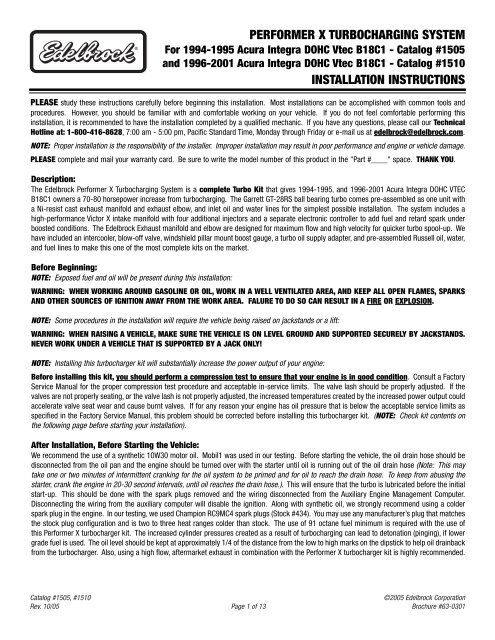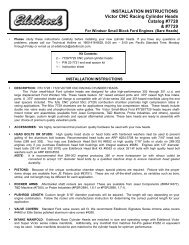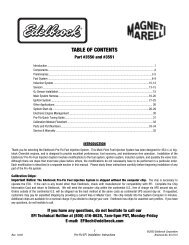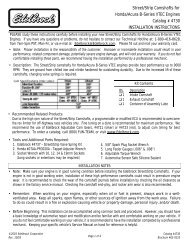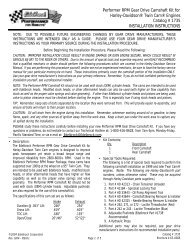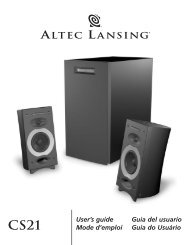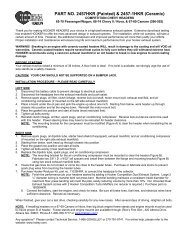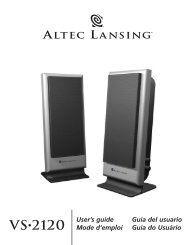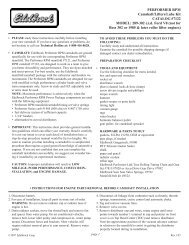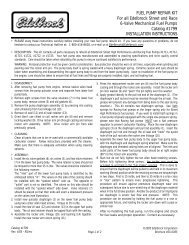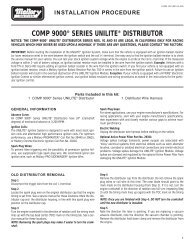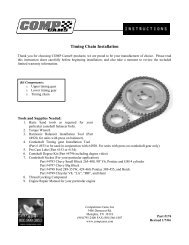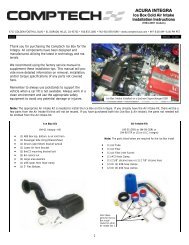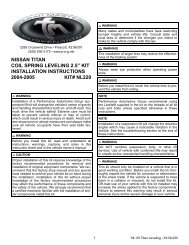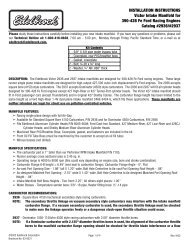1505, 1510 - Turbocharger Kits for 1994-2001 Acura Integra GSR.qxd
1505, 1510 - Turbocharger Kits for 1994-2001 Acura Integra GSR.qxd
1505, 1510 - Turbocharger Kits for 1994-2001 Acura Integra GSR.qxd
Create successful ePaper yourself
Turn your PDF publications into a flip-book with our unique Google optimized e-Paper software.
®PERFORMER X TURBOCHARGING SYSTEMFor <strong>1994</strong>-1995 <strong>Acura</strong> <strong>Integra</strong> DOHC Vtec B18C1 - Catalog #<strong>1505</strong>and 1996-<strong>2001</strong> <strong>Acura</strong> <strong>Integra</strong> DOHC Vtec B18C1 - Catalog #<strong>1510</strong>INSTALLATION INSTRUCTIONSPLEASE study these instructions carefully be<strong>for</strong>e beginning this installation. Most installations can be accomplished with common tools andprocedures. However, you should be familiar with and com<strong>for</strong>table working on your vehicle. If you do not feel com<strong>for</strong>table per<strong>for</strong>ming thisinstallation, it is recommended to have the installation completed by a qualified mechanic. If you have any questions, please call our TechnicalHotline at: 1-800-416-8628, 7:00 am - 5:00 pm, Pacific Standard Time, Monday through Friday or e-mail us at edelbrock@edelbrock.com.NOTE: Proper installation is the responsibility of the installer. Improper installation may result in poor per<strong>for</strong>mance and engine or vehicle damage.PLEASE complete and mail your warranty card. Be sure to write the model number of this product in the "Part #____" space. THANK YOU.Description:The Edelbrock Per<strong>for</strong>mer X Turbocharging System is a complete Turbo Kit that gives <strong>1994</strong>-1995, and 1996-<strong>2001</strong> <strong>Acura</strong> <strong>Integra</strong> DOHC VTECB18C1 owners a 70-80 horsepower increase from turbocharging. The Garrett GT-28RS ball bearing turbo comes pre-assembled as one unit witha Ni-resist cast exhaust manifold and exhaust elbow, and inlet oil and water lines <strong>for</strong> the simplest possible installation. The system includes ahigh-per<strong>for</strong>mance Victor X intake manifold with four additional injectors and a separate electronic controller to add fuel and retard spark underboosted conditions. The Edelbrock Exhaust manifold and elbow are designed <strong>for</strong> maximum flow and high velocity <strong>for</strong> quicker turbo spool-up. Wehave included an intercooler, blow-off valve, windshield pillar mount boost gauge, a turbo oil supply adapter, and pre-assembled Russell oil, water,and fuel lines to make this one of the most complete kits on the market.Be<strong>for</strong>e Beginning:NOTE: Exposed fuel and oil will be present during this installation:WARNING: WHEN WORKING AROUND GASOLINE OR OIL, WORK IN A WELL VENTILATED AREA, AND KEEP ALL OPEN FLAMES, SPARKSAND OTHER SOURCES OF IGNITION AWAY FROM THE WORK AREA. FALURE TO DO SO CAN RESULT IN A FIRE OR EXPLOSION.NOTE: Some procedures in the installation will require the vehicle being raised on jackstands or a lift:WARNING: WHEN RAISING A VEHICLE, MAKE SURE THE VEHICLE IS ON LEVEL GROUND AND SUPPORTED SECURELY BY JACKSTANDS.NEVER WORK UNDER A VEHICLE THAT IS SUPPORTED BY A JACK ONLY!NOTE: Installing this turbocharger kit will substantially increase the power output of your engine:Be<strong>for</strong>e installing this kit, you should per<strong>for</strong>m a compression test to ensure that your engine is in good condition. Consult a FactoryService Manual <strong>for</strong> the proper compression test procedure and acceptable in-service limits. The valve lash should be properly adjusted. If thevalves are not properly seating, or the valve lash is not properly adjusted, the increased temperatures created by the increased power output couldaccelerate valve seat wear and cause burnt valves. If <strong>for</strong> any reason your engine has oil pressure that is below the acceptable service limits asspecified in the Factory Service Manual, this problem should be corrected be<strong>for</strong>e installing this turbocharger kit. (NOTE: Check kit contents onthe following page be<strong>for</strong>e starting your installation).After Installation, Be<strong>for</strong>e Starting the Vehicle:We recommend the use of a synthetic 10W30 motor oil. Mobil1 was used in our testing. Be<strong>for</strong>e starting the vehicle, the oil drain hose should bedisconnected from the oil pan and the engine should be turned over with the starter until oil is running out of the oil drain hose (Note: This maytake one or two minutes of intermittent cranking <strong>for</strong> the oil system to be primed and <strong>for</strong> oil to reach the drain hose. To keep from abusing thestarter, crank the engine in 20-30 second intervals, until oil reaches the drain hose.). This will ensure that the turbo is lubricated be<strong>for</strong>e the initialstart-up. This should be done with the spark plugs removed and the wiring disconnected from the Auxiliary Engine Management Computer.Disconnecting the wiring from the auxiliary computer will disable the ignition. Along with synthetic oil, we strongly recommend using a colderspark plug in the engine. In our testing, we used Champion RC9MC4 spark plugs (Stock #434). You may use any manufacturer’s plug that matchesthe stock plug configuration and is two to three heat ranges colder than stock. The use of 91 octane fuel minimum is required with the use ofthis Per<strong>for</strong>mer X turbocharger kit. The increased cylinder pressures created as a result of turbocharging can lead to detonation (pinging), if lowergrade fuel is used. The oil level should be kept at approximately 1/4 of the distance from the low to high marks on the dipstick to help oil drainbackfrom the turbocharger. Also, using a high flow, aftermarket exhaust in combination with the Per<strong>for</strong>mer X turbocharger kit is highly recommended.Catalog #<strong>1505</strong>, #<strong>1510</strong>Rev. 10/05Page 1 of 13©2005 Edelbrock CorporationBrochure #63-0301
Qty. DescriptionIndividual Parts❑ 1❑ 1❑ 1❑ 1❑ 1❑ 1❑ 1❑ 1❑ 1❑ 1❑ 1❑ 1❑ 1❑ 1❑ 1❑ 1❑ 1❑ 1❑ 1Wiring Kit❑ 1❑ 1❑ 1❑ 1❑ 1❑ 1❑ 14❑ 10Hardware Kit❑ 1❑ 3❑ 1❑ 7❑ 6❑ 13❑ 3❑ 3❑ 4❑ 2❑ 2❑ 2❑ 1❑ 1❑ 3❑ 1❑ 1❑ 1❑ 1 ft.❑ 1 ft.Kit Contents<strong>Turbocharger</strong> / Exhaust Manifold / Exhaust Elbow / Oil-Water Line AssemblyPer<strong>for</strong>mer X Intake Manifold / Turbo Fuel System AssemblyOil Supply Sandwich Adapter Assembly (Note: A ½” allen wrench is required <strong>for</strong> installation of the adapter)IntercoolerCompressor Inlet Pipe, Cast AluminumCompressor Outlet Pipe, Cast AluminumIntercooler Inlet PipeIntercooler Outlet PipeIntake Manifold Inlet PipeCoolant Pipe (Lower Radiator Re-Routing)Exhaust Down PipeAir Filter / Attachment Hose / Clamps AssemblyBlow Off Valve AssemblyBoost Gauge / Plumbing AssemblyBoost Gauge Mounting Pod (Pillar Mount)Gasket, Intake ManifoldRadiator Fan (Includes Thru-Core Radiator Mounts)E.O. SheetE.O. DecalAuxiliary Engine Management ComputerVTEC Pressure Switch Control BoxMain Wiring HarnessAuxiliary Fuel Injector Wiring Harness2-Bar MAP SensorCAT SensorButt Splice Connectors, Wiring8” Tie WrapsEVAP Purge Solenoid BracketFuel Rail SpacersNylon Plug (Compressor Inlet Pipe Temp Sensor Hole)M8 x 1.25 Stainless Steel Stud (Exhaust Manifold To Cylinder Head)M8 x 1.25 Stainless Steel Nut (Exhaust Manifold To Cylinder Head)M8 Stainless Steel Split WasherM10 x 1.5 Studs (Exhaust Downpipe to Turbo Outlet Elbow)M10 x 1.5 Flange Nut (Exhaust Downpipe to Turbo Outlet Elbow)M8 x 1.25, 25mm Long Bolt (Compressor Outlet Pipe to Intercooler Inlet Pipe)¼-20 x ½” Hex Head Bolt (Turbo Oil Drain Adapter Fitting, Steel Oil Pan)Socket Head Cap Screw, M8 x 1.25, 20mm Long (Turbo Oil Drain Hose to Turbo Oil Drain Flange)M8 Spring Washer (Turbo Oil Drain Hose Mounting)M8 x 1.25, 12-point Stainless Steel Nut (Exhaust Manifold to Cylinder Head)M8 x 1.25, 12mm Long, Serrated Flange Hex Head Bolt (Compressor Inlet to Support Brace)M6, 30mm Long Serrated Flange Hex Head Bolt, Black Oxide Finish (Fuel Rail)M6 x 1.0 Serrated Flange Nut, Black Oxide Finish (A/C Bracket)M5 x 0.8 Nylock Nut (EVAP Purge Solenoid)Offset Intake Camshaft Sprocket Key (3° Advanced)18 ga. Yellow Wire18 ga. Blue WireCatalog #<strong>1505</strong>, #<strong>1510</strong>Rev. 10/05Page 2 of 13©2005 Edelbrock CorporationBrochure #63-0301
Hose Kit❑ 1❑ 1❑ 1❑ 1❑ 1❑ 1❑ 1❑ 1❑ 2❑ 2❑ 3ft.❑ 7ft.❑ 5ft.❑ 3ftKit Contents (Continued)Clutch LineTurbo Oil Drain Hose AssemblyTurbo Fuel Rail to Stock Fuel Rail Hose AssemblyFuel Filter to Turbo Fuel Rail Fuel Hose Assembly2” Silicone Hose Coupling (Compressor to Compressor Outlet Pipe)2 ½” - 3” Silicone Hose Coupling (Compressor Inlet Pipe to Compressor)2 ½ - 2 5/8” Silicone Hose Coupling (Intake Manifold Inlet Pipe to Throttle Body)2 ¼” Silicone Hose Coupling (Intercooler Outlet Pipe to Intake Manifold Inlet Pipe)2 ¼” - 2 ½” Silicone Hose Couplings (Intercooler Inlet/Outlet Pipes to Intercooler)1 ¼ - 1 3/8” Silicone Hose Coupling (Coolant Re-Route Pipe)3/8” Cam Cover Breather Hose¼” Red Silicone Hose, Wastegate & Blow-Off Valve5/16” Purge / PCV Hose¼” Fuel Hose, Fuel Pressure Regulator ReturnHose Clamp Kit❑ 1❑ 4❑ 5❑ 2❑ 4❑ 2Gasket Kit❑ 1❑ 1❑ 1❑ 1❑ 1❑ 2❑ 4❑ 1❑ 1❑ 1❑ 2Fitting Kit❑ 1❑ 1❑ 1❑ 1❑ 2❑ 1❑ 2❑ 2❑ 2❑ 1❑ 2❑ 1❑ 1Hose Clamp, 2 9/16” - 3 ½”Hose Clamps, 2 1/16” - 3”Hose Clamps, 1 13/16” - 2 ¾”Hose Clamps, 1 9/16” - 2 ½”Hose Clamps, 1 5/16” - 2 ¼”Hose Clamps, 5/16” I.D.Throttle Body to Intake Manifold GasketTurbo Outlet Elbow to Exhaust Down Pipe GasketMAT Sensor GasketO2 Sensor Bung Gasket (Second O2 Sensor Bung)Oil Drain Adapter Fitting Gasket¼” Stato Seal Washer (Turbo Oil Drain Adapter)12.3mm I.D. / 16.2mm O.D. / 1.5mm Thick, Aluminum Crush Washer (Fuel Banjo Fittings)Compressor Outlet Pipe to Intercooler Inlet Pipe O-Ring<strong>Turbocharger</strong> Oil Drain Flange O-RingInlet Air Temperature Sensor GrommetLower Intercooler Mount GrommetsThrottle Cable BracketTurbo Oil Drain Adapter Fitting10mm Barb to ¼”NPT Adapter Fitting17mm Barb to 3/8”NPT Adapter Fitting3/16” Barb to 1/8”NPT Adapter Fitting¼”NPT to ¼”NPT Female Street Elbow1/8”NPT Pipe Plugs¼” Barb to 1/8”NPT Adapter Fitting8mm Barb to 1/8”NPT Adapter Fitting9mm Barb to ¼”NPT Adapter Fitting8mm Barb to ¼”NPT Adapter Fitting3/8” Barb to ¼”NPT Male Adapter FittingPlug, O2 Sensor Bung (Second O2 Sensor Bung)Catalog #<strong>1505</strong>, #<strong>1510</strong>Rev. 10/05Page 3 of 13©2005 Edelbrock CorporationBrochure #63-0301
INSTALLATION INSTRUCTIONSInitial Parts Removal (See factory service manual <strong>for</strong> procedures where noted)1. Begin by disconnecting the battery and draining the engine oil and coolant from the engine. Remove the battery hold down using a 10mmwrench and remove the battery. Disconnect any wiring attached to the battery tray, and remove the tray, using a 12mm socket on the traybolts. Set aside. (This will provide improved access to the firewall <strong>for</strong> wiring later on.)2. Remove the front lower splash shield and front bumper cover, as per the factory service manual procedure. The front inner fender liners donot need to be removed. You can allow the front inner fender liners to hang free, remaining attached to the rear of the front wheel wellopenings. Remove the stock intake tube and upper/lower air box following the service manual instructions. Save the air box mounting boltsand grommets. These will be used to mount the compressor piping to the chassis.3. Remove the lower radiator hose. Dissconnect the upper radiator hose from the radiator only. Allow the upper radiator hose to remain attachedto the cylinder head coolant outlet. NOTE: Remember to catch any draining coolant in a pan. If it is clean, it may be reused after theinstallation is complete. Otherwise, dispose of it properly and replace with fresh fluid after finishing the installation.4. Remove the bolt holding the horn onto the center radiator support and move the horn to the side.5. Remove the driver’s side tie down bracket (tow hook) located behind the lower radiator support.6. Under the vehicle, remove the Oxygen Sensor from the factory lower exhaust header (B-Pipe), and move to the side. Disconnect the factoryB-Pipe from the Catalytic Converter, inspect the donut gasket <strong>for</strong> wear. If it is in good shape, it may be re-used. Disconnect the B-Pipe fromthe upper exhaust header. Remove the bolts holding the metal pipe portion of the heater hose to the intake manifold support bracket. Removethe lower bolts of the bracket. From above the vehicle, remove the exhaust manifold heat shield and upper exhaust manifold. If exhaustmanifold gasket is not damaged, set it aside to be reused.8. Remove the radiator cooling fan (passenger side).9. Remove the upper and lower A/C line support brackets and remove the radiator upper retaining brackets. Set these aside.Clutch Line Installation1. Remove the A/C line support bracket on the passenger side inner fender (See Fig. 1A).2. Remove the clip from the clutch line at the passenger side fender and dissconnect the flexible clutch line. Use a rag or a drip pan to catchany dripping clutch fluid. (NOTE: Be careful not to drip fluid on painted surfaces. Clutch/Brake fluid will damage paint.)3. Disconnect the clutch hard line on the transmission from the clutch slave cylinder. Remove the bolts holding the clutch line bracket on thetransmission bellhousing, and remove the bracket and clutch lines as an assembly (See Fig. 1B). Reinstall bracket bolts into the bellhousingand torque to factory specifications.4. Install the supplied Russell braided clutch line. Remember to reinstall the factory clutch line retaining clips at each end of the clutch line.5. Bleed the clutch to remove any air in the clutch system. Refer to your factory service manual <strong>for</strong> proper procedure.Remove bolts andremove bracketRemove BracketAssembly FromBellhousingFig. 1AFig. 1BCatalog #<strong>1505</strong>, #<strong>1510</strong>Rev. 10/05Page 4 of 13©2005 Edelbrock CorporationBrochure #63-0301
Offset Intake Camshaft Sprocket Key Installation1. Remove the spark plug wire cover, the spark plug wires, and the wire clamps. Remove the valvecover. Removing the spark plugs will make it easier to turn the engine over in step 8.2. Remove the plastic 'Middle' Timing belt cover (See service manual <strong>for</strong> reference).3. To simplify the timing belt adjustment, turn the engine over to TDC on the number one cylinder (closestto the belts). The “UP” arrows on the stock cam sprockets should be up, and the TDC marks aligned(See Fig. 2A).4. Inspect the timing belt <strong>for</strong> cracks or oil or coolant soaking and replace, if necessary. Refer to yourservice manual <strong>for</strong> complete replacement instructions. Wipe up any oil or solvent that gets on the beltwhile you are working on it.5. Loosen (Do not remove!) the cam sprocket mounting bolts.6. Loosen (Do not remove!) the belt tensioner-mounting bolt.7. Remove the intake cam sprocket mounting bolt and the cam sprocket.8. Install the supplied offset key and re-install the cam sprocket (See Fig. 2B).Hand tighten sprocket mounting bolt at this time.9. Slip the timing belt back over the sprockets, making sure the “UP” arrows, andTDC marks are aligned. These will be slightly offset, due to the offset key (SeeFig. 2A). Tighten intake sprocket mounting bolt to 40 ft-lbs.10. Rotate engine 5-6 revolutions (counterclockwise when facing engine pulleys) toseat the timing belt.11. Tighten the tensioner-mounting bolt to 40 ft-lbs. If you can twist the belt morethan 90° by hand, the belt is too loose. If so, check to see if the tensioner is stuckby loosening the mounting bolt and pulling up on the tensioner (use a bent hangeror hook).12. Replace the middle timing belt cover.13. Clean the valve cover seal surfaces on the head. If the seal is not cracked orhardened, it may be re-used. Press it into the receiver groove in the cover andapply automotive sensor safe silicone to the eight corner edges on the head sealsurface where the cam caps meet the head. Allow to air-dry <strong>for</strong> 10 minutesbe<strong>for</strong>e installing the cover.14. Tighten the cover to 8 ft-lbs in two or three steps (See Fig. 2C).15. You do not need to re-install the spark plug wires and cover at this time.NOTE: Remember to reset ignition timing after installation is complete.Key as viewed whenlooking at the pulleysfrom the driver’s sideTDC MARKSLINE UP(WHITE)Stock Exhaust Key(Expanded <strong>for</strong> IllustrationPurposes Only)7 3LINE UPTDC GROOVESOil Drain Adapter Installation (Note: Removal of the oil pan is required to install the turbo oil drain adapter)1. Remove the front and rear stiffening brackets connecting the block to the bell housing (See Fig. 3A). Remove the bellhousing cover. Usinga 10mm socket, remove the oil pan nuts and bolts and remove the oil pan. If necessary, gently tap on the oil pan with a rubber or plasticmallet to loosen the seal between the oil pan and the engine block. Carefully remove and inspect the oil pan gasket. If it is not cracked ortorn, it may be re-used.2. The Oil Drain Adapter requires the oil pan to be drilled. Mark the area to be drilled. Center the drain hole below the third bolt hole from thedriver’s side on the front of the oil pan (See Fig. 3B), 1.5” from the Oil Pan Rail (See Fig. 3C). Using a scratch awl, mark the center of eachbolt hole 9/16” away from the center of the center drain hole so the distance between the bolt holes, from center to center, is 1.125” (Fig.3C). Make sure this location will not interfere with the oil baffle inside the pan. If needed, move the location slightly to avoid any interferencewith the baffle (Fig. 3D).3. Using a center punch, indent each drilling location to prevent the drill bit from walking. Pre-drill each hole with a 1/8” bit. Secure the oil panon a work bench or on a drill press, and drill the outer bolt holes to ¼”. Drill the center drain hole to ½”. Deburr the holes and thoroughlyclean the oil pan to remove metal shavings.4. Install the Oil Drain Adapter onto the oil pan using the two ¼-20 x ½” bolts (We recommend using blue Loctite on the threads) and the two¼” Stato-Seal washers on the inside of the oil pan, using the gasket on the outside of the pan (See Fig. 3D). Torque the bolts to 6-8 ft/lbs.UP8 4 2SuppliedIntake Key156UPFig. 2AIntake+3°Fig. 2BFig. 2CCatalog #<strong>1505</strong>, #<strong>1510</strong>Rev. 10/05Page 5 of 13©2005 Edelbrock CorporationBrochure #63-0301
Oil pan rail1.125”1.50”Locate between 3rd& 4th bolt hole fromdriver sideFig. 3A Fig. 3B Fig. 3CUse 1/4-20 x1/2” bolts &Stato-SealwashersKeep clear of baffleFig. 3D5. Apply sealant (Permatex Ultra Grey or equivalent) to the oil pump toblock, and passenger side cover to block mating surfaces (See Fig. 3E).Reinstall the oil pan. Finger tighten nuts 1-6 to hold the pan in place(See Fig. 3E). Install remaining bolts finger tight. Tighten all nuts/boltsto 8-9 ft/lbs. Start with nuts 1-6, and tighten the remaining bolts in aclockwise manner, starting in the center and working your way out.6. Reinstall the bellhousing cover and front and rear stiffening brackets.Torque the bolts to factory service manual specifications.<strong>Turbocharger</strong> / Exhaust Manifold Assembly Installation6Oil Pump41. Using a zip-tie or twine, carefully flex the upper and lower A/C lines andthe radiator as far <strong>for</strong>ward as possible and temporarily secure. Also flexthe upper radiator hose towards the engine and temporarily secure with2zip-ties or twine. This will provide additional clearance to place theturbocharger/exhaust manifold assembly into position.Fig. 3E2. Install the seven supplied 8mm x 1.25 studs into the exhaust manifold bolt holes. Hand tighten only. Note: Do not reuse the factory exhaustbolts. Some vehicles may have factory installed studs. These may be reused, or replaced with Edelbrock studs if desired.3. Being careful not to damage the oil feed and coolant lines, or the radiator fins, bring theturbo assembly into position by lowering it into the engine compartment. It is helpful tolower it into the gap created by tying the upper radiator hose back, and moving theassembly towards the driver side and into position on the exhaust manifold studs. Usethe stock exhaust gasket. (Note: If the gasket is in good condition, it may be re-used.The gasket should show no signs of leaking, cracks, missing pieces, or burnt areas. Ifthe gasket is not in good condition, it should be replaced. Thoroughly clean flange of anyold gasket material). Using the supplied 8mm x 1.25 12-point nut on the center exhaustmanifold stud (See Fig. 4), and the six supplied 8mm x 1.25 6-point nuts, attach theturbo assembly to the engine block. You may need to bend the dipstick tube slightly toDipstick Tubeclear the exhaust manifold (See Fig. 4). Refer to the Honda Factory Service Manual <strong>for</strong>12-Point NutFig. 4torque values and sequence.4. In some instances, the A/C line near the wastegate actuator may be touching or rubbing on the wastegate actuator. If this is the case, carefullyuse a pry bar and apply smooth, even pressure to slowly flex the line away from the wastegate actuator until there is approximately 1/4”clearance between the A/C line and the actuator (See Fig. 5).5. With the turbo assembly installed, you may install the supplied electric fan inplace of the stock passenger side fan, using the supplied “Thru-core Mounts” andclips. Push the mounts through the mounting holes on the fan, sliding thembetween the radiator fins and through the radiator. Push them through the clipsand secure the fan. Trim off any excess protruding through the clips.6. Lay out the Coolant Lines and Oil Feed Line in their approximate routing locations.The Oil Feed Line (the line with the 6AN female fitting) should head down andtowards the driver’s side, then up along the driver’s side inner fender and towardsthe back of the engine, taking care not to route the line in the way of any movingparts (such as: pulleys, timing belts, etc.). The coolant lines should be routeddown toward the passenger side, then up and toward the rear of the engine.5WastegateActuator1Apply Liquid GasketA/C Line3Fig. 5Catalog #<strong>1505</strong>, #<strong>1510</strong>Rev. 10/05Page 6 of 13©2005 Edelbrock CorporationBrochure #63-0301
Factory Intake Manifold Removal1. Relieve fuel pressure first by loosening the banjo bolt connecting the fuel line to the fuel filter. Placea shop towel or rag over the wrench while loosening the banjo to soak up any fuel spray (See Fig.6). When loosening or tightening the banjo bolt on the fuel filter can, use a 19mm wrench of the hexof the fuel filter can to counteract the torque of loosening or tightening the banjo bolt. This will preventthe fuel filter can and bracket from being improperly loaded during loosening or tightening at the banjobolt.2. Disconnect the fuel injector wiring harness from the bracket on the fuel rail and unplug the harnessfrom the fuel injectors and purge valve (Note the locations of each plug on the harness to preventimproper connection during reinstallation). Disconnect the Throttle Position Sensor plug, MAP SensorFig. 6plug, and Idle Air Control Motor plug. Disconnect the purge line from the purge valve. Disconnect thefuel return line from the steel chassis fuel line. Disconnect the fuel feed line from the fuel filter. Disconnect the coolant lines from the throttlebody and manifold flange. Disconnect the vacuum lines at the rear of the manifold. The intake manifold support bracket does not need tobe removed from the intake manifold. It can be removed with the intake as an assembly since the bolts attaching it to the block were removedpreviously. Remove the throttle cable. Remove the factory intake manifold nuts. Remove the intake manifold assembly and set aside.3. Stuff the open intake ports in the cylinder head with paper towels to prevent any debris from entering the engine. Thoroughly clean the gasketsurface removing any remaining sealant or gasket material.Oil Supply Adapter Installation1. With the intake manifold removed, there will be much more clearance to install theOil Supply Adapter. Remove the stock oil filter (Replace). Install the Oil SupplySandwich Adapter in place of the stock oil filter. Make sure the O-Ring is facingtoward the engine block, and the threaded stud with ½” hex opening is facing out.Tighten with a ½” Allen Wrench. Make sure the blue fitting is facing toward thedriver’s side, pointing upward slightly, about the 10 o’clock position. On <strong>1510</strong>installations, route the supply line such that it will pass between the knock sensorand the coolant line (See Fig. 7). Install a new oil filter. Route the oil supply lineto the sandwich adapter. Using a light coat of oil on the threads, tighten the femalefitting onto the blue fitting on the sandwich adapter. Fig. 7#1 #2 #3 #4 #5 #6 #7 #8 #9Fig. 8AVictor X Manifold Installation1. (Note: Use teflon paste on the threads of fittings be<strong>for</strong>e installing them into the intakemanifold). Install the vacuum fittings, MotoTron Manifold Air Pressure (MAP) Sensor, and thestock Manifold Air Temperature (MAT) sensor on the underside of the Victor X intake manifold(See Fig. 8A). Install the water outlet fitting into the mounting flange, and install the 1/8” NPTx 8mm barb fitting (or 1/8” NPT Pipe Plug <strong>for</strong> <strong>1510</strong> installations) into the water outlet fitting(See Fig. 8B). (Refer to Fig. 8C <strong>for</strong> Fitting Descriptions).#10Fig. 8B#1 Boost Gauge Adapter Fitting (Boost GaugeLine, Found in the Boost Gauge Box)#2 3/16” Barb x 1/8” NPT (Fuel PressureRegulator Hose)#3 1/4” NPT Street Elbow & 10mm Barb x1/4” NPT (Power Brake Booster Hose)#4 3/16” Barb x 1/8” NPT (Cruise ControlVacuum Hose, if equipped), or 1/8” NPTpipe plug (No Vacuum Cruise Control))#5 Mototron MAP Sensor#6 Stock Manifold Air Temperature (MAT)Sensor#7 1/4” Barb x 1/8” NPT (Blow-Off Valve Hose)#8 8mm Barb x 1/4” NPT (PCV Hose)#9 9mm Barb x 1/4” NPT (Purge Valve Hose)#10 17mm Barb x 3/8” NPT (Manifold WaterOutlet)#11 8mm Barb x 1/8” NPT (Throttle BodyCoolant Hose) (Use 1/8” NPT Pipe Plug on<strong>1510</strong> Installations)Fig. 8C2. Remove the idle air control motor (IAC) from the factory intake manifold and install onto the Victor X intake manifold. Remove the throttlebody (with MAP sensor attached), and two throttle body studs from the factory intake manifold. Using two nuts on the studs, and jammingthem, will help get the studs out of the stock intake manifold (See Fig 9). Install the two throttle body studs into the Victor X intake manifold,one on the upper right bolt hole of the throttle body mounting flange and one on the lower left bolt hole. Install the stock throttle body andgasket onto the Victor X manifold. Remove the stock throttle cable bracket bolts, and install the supplied throttle cable bracket onto the VictorX manifold using the stock bolts. Remove the stock fuel rail/injectors/purge valve/fuel pressure regulator and install onto the Victor X manifold#11Catalog #<strong>1505</strong>, #<strong>1510</strong>Rev. 10/05Page 7 of 13©2005 Edelbrock CorporationBrochure #63-0301
using the stock hardware (Inspect all O-Rings and Seals <strong>for</strong> wear, replace if necessary). In order to usethe factory fuel pressure regulator on the Victor X intake manifold, you will need to rotate it 180° sothat the outlet is now pointing toward the valve cover. Attach the Turbo Fuel Rail to Stock Fuel Railhose assembly female end with the 180° bend to the driver’s side of the turbo fuel rail. Loop the hoseunder the Victor X intake manifold and attach the banjo end to the stock fuel rail using the stock banjonut. Use the new banjo sealing washers supplied in the kit. Attach the auxiliary fuel injector wiringharness to the auxiliary injectors.3. Using the supplied gasket, install the Victor X manifold / throttle body / fuel system assembly onto theFig. 9engine (See Fig. 10). (Remember: Remove the paper towels or rags be<strong>for</strong>e installing the intakemanifold). After placing the Victor X manifold onto the intake studs, tighten all intake nuts. Follow the factory service manual <strong>for</strong> proper torquevalues and tightening sequence. Reconnect all factory sensors and vacuum hoses. Re-connect the factory fuel injector wiring harness tothe stock fuel injectors, and re-attach the harness to the fuel rail bracket. Re-connect the stock throttle cable to the new bracket and followingthe factory service manual, adjust the throttle cable <strong>for</strong> proper operation.4. Connect the Fuel Filter to Turbo Fuel rail hose assembly. Connect the 90° banjo end to thefuel filter using the factory banjo bolt. Use the new banjo sealing washers supplied in the kit.Connect the 90°, -6 AN female end to the auxiliary fuel rail. Using the supplied ¼” SAE fuelhose, connect the fuel pressure regulator outlet to the fuel return line using the stock hoseclamps.Plumbing, and Intercooler Installation1. Remove the horn from the stock location.2. Remove the bumper beam gusset on passenger side (black ABSplastic) to access the bumper bolts (See Fig. 11). Remove theouter bumper bolt (under gusset, goes through to the inner fender)and replace it with the supplied 25mm long bolt. Using an 8mmnut, attach the horn to this new bolt (See Fig. 11). Replace thebumper beam gusset.3. Attach the Oil Drain Hose Assembly to the turbo housing using thetwo 8mm x 1.25 (20mm long) Socket Head Capscrews and the two8mm spring washers. Be sure the Turbo Oil Drain flange O-Ring isin place. (A bit of grease on the O-Ring helps to hold it in place).The bend in the fitting at the turbo end should point toward thefront of the vehicle. Attach the female AN fitting to the Oil DrainAdapter on the oil pan. Make sure the hose is not kinked.4. There is an A/C line in front of the power steering cooler line. This will need to be modified in order <strong>for</strong> the intercooler to fit properly. Removethe bolts holding the power steering cooler line to the radiator support. Carefully flex the power steering line out of the way, and carefullybend the A/C line by pushing it towards the radiator. It should sit between the power steering cooler line and the radiator when the powersteering cooler line is flexed back to its original position. Reinstall power steering cooler line mounting bolts. NOTE: When modifiing tubing,always CAREFULLY and SLOWLY bend the line to avoid damaging or kinking the tubing.5. Install the intercooler grommets into the holes in the lower radiator support as shown (See Fig. 11). Using a small amount of silicone-basedspray lubricant on the grommets will make installation easier. Mount the intercooler by pressing the pins on the lower edge of intercoolerinto the grommets (See Fig. 11). Attach intercooler brace to center radiator support using supplied 6mm x 1.0, black oxide, serrated flangebolt and nut, and 1/4” zinc plated washer.6. Attach Compressor Outlet Pipe to thecompressor outlet using the suppliedsilicone connector and the appropriate hoseclamps. The outlet of the compressor outletpipe should face toward the driver’s side ofthe vehicle (See Fig. 12A). Attach theintercooler inlet pipe to the compressoroutlet pipe using the three 8mm x 1.25(25mm long) bolts, O-Ring (Use a bit ofgrease on the O-Ring to hold in place), andRelocate Horn to Rearof Bumper SupportFig. 12AGusset RemovedFig. 10Install Grommets And PressIntercooler Pins Into PlaceFig. 11Bracket attaches tothe factory tie-downbracket locationFig. 12BCatalog #<strong>1505</strong>, #<strong>1510</strong>Rev. 10/05Page 8 of 13©2005 Edelbrock CorporationBrochure #63-0301
the three 8mm split lockwashers. Attach the intercooler inlet pipe to the intercooler using a 2¼” to 2 ½” silicone coupling and the appropriate hose clamps. Attach the bracket on theintercooler inlet pipe to the factory tie-down bracket location (which was removed earlier) usingthe factory bolt (See Fig. 12B). Attach the intercooler outlet pipe to the intercooler with oneof the 2 ¼” to 2 ½” silicone couplings and the appropriate hose clamps. Bolt the supportbracket on the pipe to the inner fender using one of the factory lower airbox bolts.7. Install the Blow-Off Valve onto the intake manifold inlet pipe. Make sure the O-Ring is properlyseated on the Blow-Off Valve flange. Install the Blow-Off Valve and V-Band and tighten the V-Band. Install the supplied banjo fitting onto the Blow-Off Valve using the supplied sealingwashers. Install a 1/4” barb to 1/8” NPT fitting (<strong>for</strong> wastegate actuator hose) into the hole nearthe throttle body end of the intake manifold inlet pipe (See Fig. 13). Install the CAT (ChargeAir Temp) sensor in to the threaded fitting next to the wastegate fitting on the intake manifoldinlet pipe (See Fig. 13). Use thread sealant on the threads of the sensor and the fitting.8. Attach the intake manifold inlet pipe to the intercooler outlet pipe using the 2 ¼” siliconecoupling and the appropriate hose clamps. Attach the intake manifold inlet pipe to the throttlebody using one of the 2 ½” to 2 5/8” silicone couplings and the appropriate hose clamps.Attach the intake manifold inlet pipe to the passenger side shock tower using one of the stockair box bolts.9. Install the factory O2 sensor into the Exhaust Down-Pipe. Thread the three 10mm x 1.5 studsinto the exhaust elbow, hand tight. Making sure the exhaust down-pipe gasket is in place,install the exhaust down-pipe onto the exhaust elbow using the provided 10mm x 1.5 flangednuts. Using the stock donut gasket (if in good condition), attach the exhaust down-pipe to thestock catalytic converter using the factory bolts. Attach the down pipe to the lower exhaustbracket using the factory bolts (See Fig. 14).10. If applicable, press the supplied nylon plug into the non-threaded hole on the compressor inletpipe. Install a 3/8” barb x ¼” NPT fitting into the threaded hole in the pipe. Fit the CompressorInlet Pipe to the compressor inlet using the supplied silicone coupling and clamps (See Fig.15A). Do not fully tighten. Adjust the compressor Inlet pipe <strong>for</strong> alignment, and connect thecompressor inlet pipe to the brace on the Intake Manifold Inlet Pipe using the M8 x 1.25 (25mmlong) bolt (See Fig. 15B). Tighten all nuts/bolts and hose clamps. Connect Air Filter Assemblyto the compressor inlet pipe using the supplied silicone coupling and hose clamps.11. Cut the 3/8” hose to length and connect it to the fitting on the compressor inlet pipe on one endand to the valve cover breather port on the other end.Coolant Line and Vacuum Hose Connections1. Install the supplied coolant hard pipe in place of the lower radiator hose, using the suppliedsilicone couplings and hose clamps (See Fig. 16).2. Route one of the coolant lines from the turbo to the throttle body. Cut to fit and connect the lineto the fitting on the throttle body (See Fig. 17). On <strong>1505</strong> instalations, route the other coolantline from the turbo to coolant fitting #11 from Fig. 8C. Cut to fit and connect at fitting #11. On<strong>1510</strong> installations, route the line to the fitting under the distributor that originally connected tothe hose running to the throttle body. Use the supplied hose clamps to secure.3. Measure and cut to length the ¼” RedSilicone Hose and connect the wastegateto the fitting on the intake manifold inletpipe specified in step 6 of the “Plumbingand Intercooler Installation” section.Measure and cut to length the ¼” RedSilicone Hose and connect the Blow-OffValve to the fitting on the intake manifoldspecified in Fig. 8C.CoolantHardpipeFig. 16Connect atThrottle BodyFig. 13Fig. 14Fig. 15AM8 BoltFig. 15BFig. 17Catalog #<strong>1505</strong>, #<strong>1510</strong>Rev. 10/05Page 9 of 13©2005 Edelbrock CorporationBrochure #63-0301
Auxiliary Engine Management Computer Installation1. (Note: Whenever cutting wires, do not cut next to the plug end. Make sure to leave room<strong>for</strong> a new connection. See Fig. 18). Directly above the A/C condensation drain is anunused rubber grommet. Use a sharp blade to cut a round hole approximately 1/2” indiameter in the center of the grommet. Insert an electrician’s “fishing wire” or astraightened out wire hanger through the grommet and under the dashboard.2. Working from under the dash, attach the Edelbrock/MotoTron 3-wire MAP sensor connector(labeled “MAP”) to the hanger or wire with tape, and “fish” the connector through the holein the grommet. Repeat the procedure <strong>for</strong> the red power wire ring connector, “ChargeTemp” 2-wire connector, black ground wire, and the pink and red injector wires.3. Attach the MAP sensor connector to the Edelbrock/MotoTron MAP sensor (installed into theVictor X intake manifold) and attach the Charge Temp sensor connector to the sensor in theintake manifold inlet pipe.4. Using the supplied butt-splice connectors, connect the pink and red injector wires to the same colored wires on the auxiliary injector wireharness which should already be connected to the injectors. Use a heat gun or blowdrier to shrink the butt-splice connector insulation. Usea piece of heavy cardboard to shield any nearby electrical tape or other components that could be damaged by heat. NOTE: DO NOT USEA LIGHTER OR OTHER OPEN FLAME IN THE ENGINE COMPARTMENT TO SHRINK THE SPLICE CONNECTOR INSULATION.5. Remove the engine compartment fuse box cover and use an 8mm socket to remove the screw holding the white power wire. Connect thered power wire to this terminal using the stock screw.6. The black ground wire should be connected to the battery grounding strap on the shock tower. Make sure this connection is clean and freeof corrosion.7. Remove the passenger side kick panel to access the factory ECU. Remove the ECU from its bracket. Partially unwrap the wiring harnesscoming out of the factory ECU to have more room to work with the wiring. Continue wiring according to the model year of your vehicle aslisted below.<strong>1994</strong>-1995 VehiclesA. Unplug the A (26 pin) and D (22 pin) plugs from the factory ECU.B. The Edelbrock/MotoTron ECU modifies the VTEC switching RPM: Locate the VTEC Signal wire (VTSOL) on the wire side of the factorywiring harness near the ECU. This is a green wire with a yellow stripe, located in position A4 (See Fig. 19). Cut the wire and strip bothends. The end leading to the engine compartment should be connected to the grey wire (VTEC) on the Edelbrock harness. The endleading to pin A4 is connected to the red wire on the Edelbrock VTEC Pressure Switch Control Box. The Edelbrock VTEC Pressure SwitchControl Box is the small black box with black, purple, and red wires.C. The Edelbrock/MotoTron ECU modifies the ignition signalto control the ignition timing: Locate the Ignition Control WIRE SIDE OF FEMALE TERMINALSA21 A23 A25wire (ICM1). It is a yellow wire with a green stripe, foundat pin A21 (See Fig. 19). Cut the wire and strip bothends. Connect the end leading to the enginecompartment to the green/black wire (EST1) on theEdelbrock harness. The end leading to pin A21 should beconnected to the red wire (CRANK+) on the Edelbrockharness.D. The Edelbrock/MotoTron ECU needs a switched 12 voltsource: Locate the Ignition Power wire (IGP1), which is ayellow wire with a black stripe, located at pin A25 (SeeFig. 19). Cut the wire and strip the ends. With a buttspliceconnector, connect both ends to the purple wire(KEYSWITCH) on the Edelbrock harness.A(26 pin)D(22 pin)NewConnection(Leave Roomwhen CuttingWires)Fig. 181 3 5 7 9 13 15 17 19 21 23 25INJ1 INJ2 INJ3 FLR1 IACV MIL ACC IAB CS ALT C ICM 1 PG1 IGP12 4 6 12 16 20 24 26INJ4 VTSOL O2S HTC FANC ACC PCS PG2 LG11 3 7 9 11 13 15 17 19 21VBU KS TXD/RXD A_TF TPS ECT SCS MAP(PB) VCC1 SG12 4 6 8 10 14 16 20 22BK SW SCS VTP SW BARO OUT ELD O2S VREF VCC2 SG2E. The Edelbrock/MotoTron ECU and the Edelbrock VTEC pressure control switch both need to be grounded: Locate an ECU ground wire(PG1 or PG2). It is a heavier black wire found at pin A23 (PG1) and also at A24 (PG2) (See Fig. 19). Cut and strip both ends of eitherground wire. Connect one end of the factory ECU ground wire and the black (GROUND) wire on the Edelbrock harness into one side ofa splice connector, and the other end of the factory ECU ground wire and the black wire on the Edelbrock VTEC pressure switch controlbox into the other side of the splice connector. You may also use more than one butt-splice connector, or make more than one connectionto PG1 or PG2 if necessary.A4D6A24Fig. 19Catalog #<strong>1505</strong>, #<strong>1510</strong>Rev. 10/05Page 10 of 13©2005 Edelbrock CorporationBrochure #63-0301
F. The Edelbrock VTEC Pressure Switch Control Box needs to intercept the VTEC oil pressure signal: Locate the VTEC pressure switch wire(VTP SW). It is a blue wire with a black stripe located at pin D6 (See Fig. 19). Cut the wire and strip only the end leading to ECU pinD6. Connect the purple wire from the Edelbrock VTEC pressure switch control box to the stripped end. Leave the other end (the oneleading to the engine compartment) unconnected. Cover the end of it with electrical tape to prevent it from making an accidentalconnection.1996-1999 VehiclesA. Unplug the A (32 pin) and C (31 pin) plugs from the factory ECU.B. The Edelbrock/MotoTron ECU modifies the VTEC switching RPM: Locate the VTEC Signal wire (VTSOL) on the wire side of the factorywiring harness near the ECU. This is a green wire with a yellow stripe, located in position A8 (See Fig. 20). Cut the wire and strip bothends. The end leading to the engine compartment should be connected to the grey wire (VTEC) on the Edelbrock harness. The endleading to pin A8 is connected to the red wire on the Edelbrock VTEC Pressure Switch Control Box. The Edelbrock VTEC Pressure SwitchControl Box is the small black box with black, purple, and red wires.C. The Edelbrock/MotoTron ECU modifies the ignitionsignal to control the ignition timing: Locate theIgnition Control wire (ICM1). It is a yellow wirewith a green stripe, found at pin A20 (See Fig.20). Cut the wire and strip both ends. Connectthe end leading to the engine compartment to thegreen/black wire (EST1) on the Edelbrockharness. The end leading to pin A20 should beconnected to the red wire (CRANK+) on theEdelbrock harness.D. The Edelbrock/MotoTron ECU needs a switched12 volt source: Locate the Ignition Power wire(IGP1), which is a yellow wire with a black stripe,located at pin A24 (See Fig. 20). Cut the wireand strip the ends. With a butt-splice connector,connect both ends to the purple wire(KEYSWITCH) on the Edelbrock harness.WIRE SIDE OF FEMALE TERMINALSA(32 pin)C(31 pin)1 2 3 4 5 6 8 9 10 11SO2S PO2SINJ4 INJ3 INJ2 INJ1 HTC HTC VT SOL LG1 PG1 IGP112 15 16 17 18 19 20 22 23 24IACV PCS FLK1 ACC MIL ALT C IGH1 LG2 PG2 IGP225 26 27IABVREF CS FAN C1 2 3 4 5 6 7 8 9 10C1 C2 C3 C4 ACS STS SCS TXD/RXD FAS VBU11 12 13 14 15 16 17 18 19 21BAROCKF M CKP M TDC M CYP M VTP SW PSP SW ALT F VSS AT CHK OUT27 28 29AFSB AFSA ATP PNE. The Edelbrock/MotoTron ECU and the Edelbrock VTEC pressure control switch both need to be grounded: Locate an ECU ground wire(PG1 or PG2). It is a heavier black wire found at pin A10 (PG1) and also at A23 (PG2) (See Fig. 20). Cut and strip both ends of eitherground wire. Connect one end of the factory ECU ground wire and the black (GROUND) wire on the Edelbrock harness into one side ofa splice connector, and the other end of the factory ECU ground wire and the black wire on the Edelbrock VTEC pressure switch controlbox into the other side of the splice connector. You may also use more than one butt-splice connector, or make more than one connectionto PG1 or PG2 if necessary.F. The Edelbrock VTEC Pressure Switch Control Box needs to intercept the VTEC oil pressure signal: Locate the VTEC pressure switch wire(VTP SW). It is a blue wire with a black stripe located at pin C15 (See Fig. 20). Cut the wire and strip only the end leading to ECU pinC15. Connect the purple wire from the Edelbrock VTEC pressure switch control box to the stripped end. Leave the other end (the oneleading to the engine compartment) unconnected. Cover the end of it with electrical tape to prevent it from making an accidentalconnection.2000-<strong>2001</strong> VehiclesA. Unplug the B (25 pin) and C (31 pin) plugs from the factory ECU.B. The Edelbrock/MotoTron ECU modifies the VTEC switching RPM: Locate the VTEC Signal wire (VTS) on the wire side of the factory wiringharness near the ECU. This is a green wire with a yellow stripe, located in position B12 (See Fig. 21). Cut the wire and strip both ends.The end leading to the engine compartment should be connected to the grey wire (VTEC) on the Edelbrock harness. The end leading topin B12 is connected to the red wire on the Edelbrock VTEC Pressure Switch Control Box. The Edelbrock VTEC Pressure Switch ControlBox is the small black box with black, purple, and red wires.C. The Edelbrock/MotoTron ECU modifies the ignition signal to control the ignition timing: Locate the Ignition Control wire (ICM). It is ayellow wire with a green stripe, found at pin B13 (See Fig. 21). Cut the wire and strip both ends. Connect the end leading to the enginecompartment to the green/black wire (EST1) on the Edelbrock harness. The end leading to pin B13 should be connected to the red wire(CRANK+) on the Edelbrock harness.C15A20A8A10A23A24Fig. 20Catalog #<strong>1505</strong>, #<strong>1510</strong>Rev. 10/05Page 11 of 13©2005 Edelbrock CorporationBrochure #63-0301
D. The Edelbrock/MotoTron ECU needs a switched 12 voltsource: Locate the Ignition Power wire (IGP1), which is ayellow wire with a black stripe, located at pin B1 (See Fig.21). Cut the wire and strip the ends. With a butt-spliceconnector, connect both ends to the purple wire(KEYSWITCH) on the Edelbrock harness.E. The Edelbrock/MotoTron ECU and the Edelbrock VTECpressure control switch both need to be grounded: Locatean ECU ground wire (PG1 or PG2). It is a heavier black wirefound at pin B2 (PG1) and also at B10 (PG2) (See Fig. 21).Cut and strip both ends of either ground wire. Connect oneend of the factory ECU ground wire and the black (GROUND)wire on the Edelbrock harness into one side of a spliceconnector, and the other end of the factory ECU ground wireand the black wire on the Edelbrock VTEC pressure switchcontrol box into the other side of the splice connector. Youmay also use more than one butt-splice connector, or makemore than one connection to PG1 or PG2 if necessary.WIRE SIDE OF FEMALE TERMINALSB1 B2B(25 pin)C(31 pin)F. The Edelbrock VTEC Pressure Switch Control Box needs to intercept the VTEC oil pressure signal: Locate the VTEC pressure switch wire(VTM). It is a blue wire with a black stripe located at pin C10 (See Fig. 21). Cut the wire and strip only the end leading to ECU pin C10.Connect the purple wire from the Edelbrock VTEC pressure switch control box to the stripped end. Leave the other end (the one leadingto the engine compartment) unconnected. Cover the end of it with electrical tape to prevent it from making an accidental connection.8. Mount the Edelbrock/MotoTron ECU and Edelbrock VTEC Pressure Switch Control box under the dash in a convenient location, securing themwith wire ties. Using a heat gun, shrink the insulation on the butt-splice connectors. Use a piece of heavy cardboard to shield carpeting andany nearby electrical tape or other components that could be damaged by heat. Wrap the newly connected wiring with electrical tape toprotect it and secure with tie wraps as necessary. Reconnect the ECU plugs to the factory ECU and reinstall the factory ECU. Replace thepassenger side kick panel.Bumper Cover and Fender Liner Modification and Final Parts Re-installation1. On the inside of the front bumper cover, material from the back side of the grill will need to betrimmed to clear the intercooler. Temporarily place bumper cover on the vehicle and check <strong>for</strong>clearance. Using a cutoff wheel, trim areas that contact the intercooler. This may vary if anaftermarket bumper cover has been installed. Factory turn signal lights will fit. However, brackets<strong>for</strong> turn signal lights in the bumper may need to be modified. Temporarily place bumper cover onthe vehicle again and check <strong>for</strong> clearance. Continue to trim as necessary.2. After fitting the bumper cover, temporarily place each fender liner in place and mark area whereinterference with the intake piping occurs. Trim out material as needed (See Fig. 22).3. Install the fender liners and bumper cover following the Factory Service Manual instructions. Useany remaining tie-wraps to secure any cut sections of the fender liners if necessary.4. After fitting the fender liners, you will need to modify the radiator support brackets that wereremoved during the beginning of this installation. It is beneficial to hold the radiator slightly<strong>for</strong>ward of it’s original position to provide clearance. Using a hammer or bench vise, carefullyflatten the tab at the end of the radiator support brackets. Elongate the bolt hole in each brackettowards the radiator side of the bracket using a die grinder or file. Elongate the bolt holes byapproximately 1/4”. Install the brackets, leaving the bolts somewhat loose. Carefully flex theradiator as far <strong>for</strong>ward as you can and tighten the bolts (See Fig. 23). Remove the A/C linesupport bracket bolt. Carefully flex the A/C line <strong>for</strong>ward, sliding the bracket over to the left, andreattaching it to the body with the stock bolt and the supplied M6 x 1.0 black oxide coated,serrated flange nut. Attach it to the unused hole slightly left and <strong>for</strong>ward of the stock bolt hole.5. Install the battery tray and battery. Install the battery tie down and reconnect the battery cables.1 2 3 4 5 8IGP1 PG1 INJ2 INJ3 INJ4 LS-9 10 12 13 11 16 17IGP2 PG2 INJ1 VTS ICM IAB SOL LS+20 21 22 23LG1 VBU LG2 IACV1 2 3 5 7 8 9 10PO2SHTC ALTC KS ALT F IACV P CKPF CKPM VTM16 18 20 21 2217 19PHO2S MAP SG2 VCC1 TDCF TDCM CKFP23 25 26 27 28 29 30 31VSS IAT ECT TPS VCC2 CYPP CYPM CKFMElongate BoltHole TowardsRadiator SideFlatten TabTrim FenderLinder AsNeeded6. Fill the oil to the level recommended in the “Final Checklist” on page 13, and fill coolant to Factory Service Manual specifications.B10B12B13C10Fig. 21Fig. 22Fig. 23Catalog #<strong>1505</strong>, #<strong>1510</strong>Rev. 10/05Page 12 of 13©2005 Edelbrock CorporationBrochure #63-0301
Boost Gauge and Boost Gauge Mounting Pod Installation1. Follow the installation instructions included with the boost gauge and mounting pod <strong>for</strong> installation. Remember, the boost guage line willconnect to fitting #1 in Figure 8C. NOTE: The boost gauge MUST be installed to allow you to properly monitor the amount of boostpressure. If the boost reads higher than normal (6-8 psi) <strong>for</strong> any reason, do not drive the vehicle. Running higher thanrecommended boost pressures on a stock engine could result in engine damage if driven repeatedly. Contact our Tech Lineat: 800-416-8628 <strong>for</strong> assistance if overboost occurs.Final Checklist (Note: Do not start vehicle be<strong>for</strong>e completing this list.)❑ Make sure that all fluids are at the recommended factory levels. However, the oil level should be kept at approximately 1/4 of the distancefrom the low to high marks on the dipstick to help oil drainback from the turbocharger. Check oil level more often to make sure it does notrun below the low mark on the dipstick (See Fig. 24). (Note: As stated above, we recommend the use of a synthetic 10W30 motor oil.Mobil1 was used in our testing.)❑ Prime the turbocharger oil supply. Be<strong>for</strong>e starting the vehicle, the turbocharger oil drain hoseHighshould be disconnected from the oil pan and the engine should be turned over with starter untilMarkoil is running out of the oil drain hose. This will ensure that the turbo is lubricated be<strong>for</strong>e initialstart-up. This should be done with the spark plugs removed and the wiring harness plugdisconnected from the Auxiliary Engine Management Computer. Disconnecting the wiringharness from the Auxiliary Engine Management Computer will disable the ignition (Note: It maytake one or two minutes of intermittent cranking <strong>for</strong> the oil system to be primed and <strong>for</strong> oil toreach the drain hose. To keep from abusing the starter, crank the engine in 20-30 secondintervals, until oil reaches the drain hose.). Once oil flow is established, reconnect theturbocharger oil drain hose and Auxiliary Engine Management Computer. Check the oil levelagain after priming the oil supply.❑ Make sure the oil drain hose has no kinks, and that portions of the hose do not hang more than slightly lower than the drain fitting in the oilpan. This can cause a back-up of oil in the hose, preventing proper draining of oil from the turbo housing. This can result in small amountsof oil being drawn into the turbine housing, causing oil smoke to be seen coming from the exhaust.❑ Along with synthetic oil, we strongly recommend using a colder sparkplug in the engine. In our testing, we used Champion RC9MC4sparkplugs (stock #434). You may use any manufacturer’s plug that matches the stock plug configuration and is two to three heat rangescolder than stock.❑ Start the engine and check <strong>for</strong> any vacuum, fuel, or oil leaks.❑ Reset ignition timing to factory specifications. NOTE: Ignition timing MUST be reset. Possible engine damage may occur if timing is not reset.❑Keep levelbetweenLow and1/4 FullFig. 24Use only premium grade 91 octane (or higher) fuel with this turbo kit. Lower grade fuel can cause pre-ignition (knock), and possible enginedamage, if used.Maintenence and ServiceFollow your regular factory recommended service intervals. However, we recommend changing the oil every 3000 miles, as compared to thefactory recommended 7500 miles.Special NoticeThis Edelbrock part has received an Executive Order number (E.O. #) from the Cali<strong>for</strong>nia Air Resources Board (C.A.R.B.) making it legal <strong>for</strong> streetuse on pollution-controlled motor vehicles in all 50 states. To assist you with emissions inspection, we have included a silver E.O. decal to verifythat this part is a legal replacement part on the vehicle <strong>for</strong> which it is cataloged. The adhesive-backed decal should be affixed next to the existingemission and engine specification decal. Do not cover your original equipment specification decal with the Edelbrock E.O. decal.LowMarkEdelbrock Corporation • 2700 Cali<strong>for</strong>nia Street • Torrance, CA 90503Tech Line: 800-416-8628 • E-Mail: edelbrock@edelbrock.comCatalog #<strong>1505</strong>, #<strong>1510</strong>Rev. 10/05Page 13 of 13©2005 Edelbrock CorporationBrochure #63-0301


